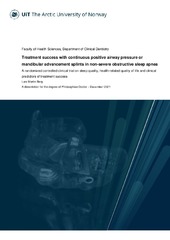| dc.contributor.advisor | Bugten, Vegard | |
| dc.contributor.author | Berg, Lars Martin | |
| dc.date.accessioned | 2022-02-15T08:39:20Z | |
| dc.date.available | 2022-02-15T08:39:20Z | |
| dc.date.issued | 2022-04-04 | |
| dc.description.abstract | Obstructive sleep apnea (OSA) is a respiratory sleep-disorder characterized by repeated breathing cessations due to pharyngeal soft tissue collapse, leading to several medical disorders and possibly premature death. Two commonly used treatment alternatives for OSA are continuous positive airway pressure (CPAP) and mandibular advancement splints (MAS). The overall aim of this randomized clinical trial was to compare CPAP and MAS treatment regarding efficacy, compliance to treatment and the impact on self-reported sleep quality and health-related quality of life (HRQoL) among patients with non-severe OSA.
In total, 104 adult patients were randomly allocated to CPAP or MAS treatment and evaluated after 4- and 12 months of treatment. Both intention-to-treat and per protocol analyses were performed for the comparisons between the treatment groups. While the number of residual respiratory events at follow-ups were lower in the CPAP treatment group than in the MAS treatment group, the compliance to MAS treatment was significantly better than compliance to CPAP treatment. The subjective sleep quality and HRQoL were similar between the treatment groups at the follow-up visits.
CPAP remains the primary choice of treatment, but the comparable effect on patient-reported outcomes between CPAP and MAS treatment combined with the better compliance to MAS treatment suggests that MAS should be available as a standard treatment option for patients with non-severe OSA. The Friedman tongue position score does not seem to predict the treatment success and compliance to CPAP and MAS treatment in patients with non-severe OSA. | en_US |
| dc.description.abstract | Obstruktiv søvnapné (OSA) er en søvnlidelse som karakteriseres av gjentatte pustestans som følge av mykvevskollaps i svelget. Dette fører økt risikoen for alvorlig sykdom og tidlig død. To vanlige behandlingsalternativ for OSA er kontinuerlig luftveisovertrykk (CPAP) og søvnapnéskinner (MAS). Målet med denne randomiserte kliniske studien var å sammenligne behandling med CPAP og MAS med hensyn til bedring i antall pustestans, behandlingsetterlevelse og virkningen fra behandlinga på opplevd søvnkvalitet og helserelatert livskvalitet blant pasienter med ikke-alvorlig OSA.
Totalt 104 voksne pasienter ble tilfeldig satt til behandling med CPAP eller MAS og fulgt opp med kontroller etter 4- og 12 måneder. Både «intention-to-treat-analyser» og «per protocol-analyser» ble utført ved sammenligning av behandlingsgruppene. Mens CPAP-behandlinga var klart best til å redusere antallet pustestans, var etterlevelsen til MAS-behandling betydelig bedre enn ved CPAP-behandling. Det var ingen forskjell i opplevd søvnkvalitet og helserelatert livskvalitet mellom CPAP- og MAS-gruppene etter 12 måneder med behandling.
Det kan konkluderes med at søvnkvalitet og helserelatert livskvalitet etter 12 måneder med CPAP- og MAS-behandling var lik, til tross for stor forskjell i antall pustestans ved behandling. CPAP er fortsatt førstevalg ved behandling av ikke-alvorlig OSA, men effekten på pasient-rapportert søvnkvalitet og helserelatert livskvalitet sammen med god behandlingsetterlevelse tilsier at MAS burde være et tilgjengelig behandlingsalternativ til CPAP. Videre kan det se ut til at Friedmans skår for tungeposisjon ikke kan predikere vellykkethet og etterlevelse i behandling med CPAP eller MAS blant pasienter med ikke-alvorlig OSA. | en_US |
| dc.description.doctoraltype | ph.d. | en_US |
| dc.description.popularabstract | Obstructive sleep apnea (OSA) is a disorder where the soft tissues behind the tongue repeatedly collapses during sleep. OSA is may lead to several serious medical disorders. In this randomized clinical trial, we studied the effectiveness of two different treatment options for the treatment of non-severe OSA. Patients in the study were treated for 12 months, where 55 used “continuous positive airway pressure” and 49 used “mandibular advancement splints” when sleeping. We found that patient reported sleep quality and health-related quality of life were similar with these treatment options, despite differences in efficacy. Differences in efficacy being balanced by differences in compliance to treatment is a likely reason for this finding. The results suggest that “continuous positive airway pressure” is the primary choice of treatment, but both treatments should be available for patients with non-severe OSA. However, predicting the efficacy and compliance to treatment seems difficult. | en_US |
| dc.description.sponsorship | UiT Norges Arktiske Universitet,
Universitetssykehuset Nord-Norge,
St. Olavs Hospital | en_US |
| dc.identifier.uri | https://hdl.handle.net/10037/24049 | |
| dc.language.iso | eng | en_US |
| dc.publisher | UiT The Arctic University of Norway | en_US |
| dc.publisher | UiT Norges arktiske universitet | en_US |
| dc.relation.haspart | <p>Paper I: Berg, L.M., Ankjell, T.K.S., Trovik, T.A., Sjögren, A., Rikardsen, O.G., Moen, K., Sun, Y-Q. & Bugten, V. (2020). Self-reported sleep quality with mandibular advancement device or continuous positive airway pressure: A randomized clinical trial on patients with mild and moderate obstructive sleep apnea. <i>Journal of Dental Sleep Medicine, 7</i>(2). Adapted and printed with permission from the American Academy of Dental Sleep Medicine. Also available in Munin at <a href= https://hdl.handle.net/10037/20471>https://hdl.handle.net/10037/20471</a>.
<p>Paper II: Berg, L.M., Ankjell, T.K.S., Sun, Y-Q., Trovik, T.A., Sjögren, A., Rikardsen, O.G., … Bugten, V. (2020). Friedman score in relation to compliance and treatment response in non-severe obstructive sleep apnea. <i>International Journal of Otolaryngology, 2020</i>, 6459276. Also available in Munin at <a href=https://hdl.handle.net/10037/18246>https://hdl.handle.net/10037/18246</a>.
<p>Paper III: Berg, L.M., Ankjell, T.K.S., Sun, Y-Q., Trovik, T.A., Rikardsen, O.G., Sjögren, A., … Bugten, V. (2020). Health-related quality of life and sleep quality after 12 months of treatment in non-severe obstructive sleep apnea: A randomized clinical trial with Continuous Positive Airway Pressure and Mandibular Advancement Splints. <i>International Journal of Otolaryngology, 2020</i>, 2856460. Also available in Munin at <a href=https://hdl.handle.net/10037/19060>https://hdl.handle.net/10037/19060</a>. | en_US |
| dc.rights.accessRights | openAccess | en_US |
| dc.rights.holder | Copyright 2022 The Author(s) | |
| dc.rights.uri | https://creativecommons.org/licenses/by-nc-sa/4.0 | en_US |
| dc.rights | Attribution-NonCommercial-ShareAlike 4.0 International (CC BY-NC-SA 4.0) | en_US |
| dc.subject | VDP::Medisinske Fag: 700::Klinisk medisinske fag: 750::Otorhinolaryngologi: 755 | en_US |
| dc.subject | VDP::Medical disciplines: 700::Clinical medical disciplines: 750::Otolaryngology: 755 | en_US |
| dc.subject | VDP::Medisinske Fag: 700::Klinisk odontologiske fag: 830::Andre kliniske odontologiske fag: 849 | en_US |
| dc.subject | VDP::Medical disciplines: 700::Clinical dentistry disciplines: 830::Other clinical dentistry disciplines: 849 | en_US |
| dc.title | Treatment success with continuous positive airway pressure or mandibular advancement splints in non-severe obstructive sleep apnea: A randomized controlled clinical trial on sleep quality, health-related quality of life and clinical predictors of treatment success | en_US |
| dc.type | Doctoral thesis | en_US |
| dc.type | Doktorgradsavhandling | en_US |


 English
English norsk
norsk



